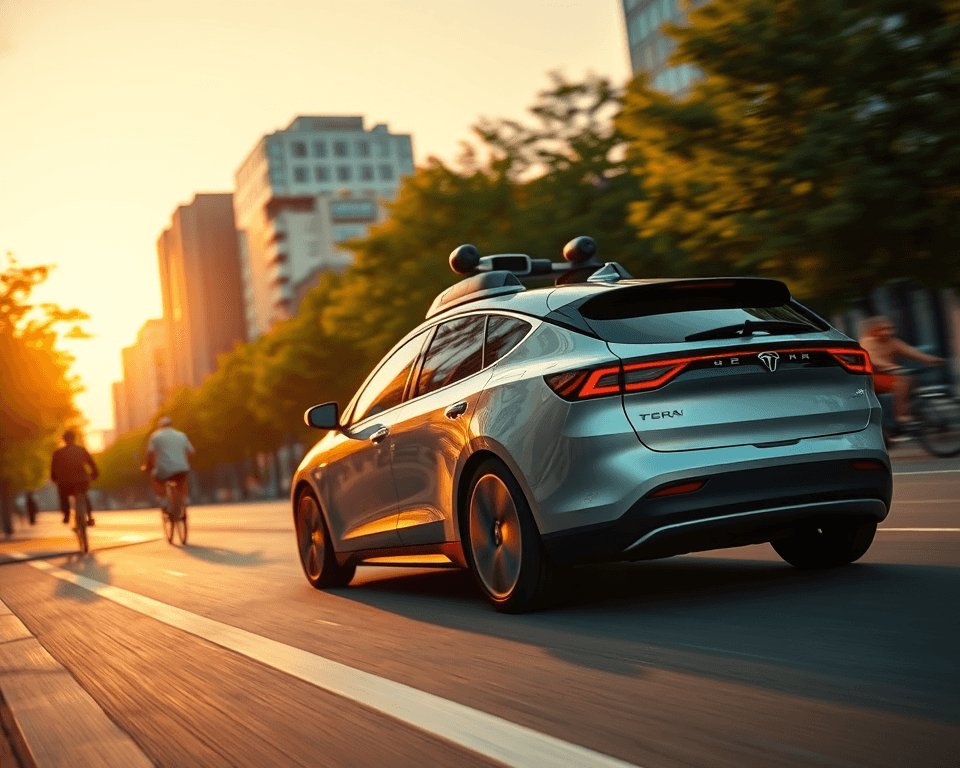When I think about the future of driving, I can’t help but feel a rush of excitement. Self-driving cars are no longer a far-off dream; they’re here, changing the way we think about transportation. Imagine never having to fight traffic or search endlessly for a parking spot. It’s not just about saving time—this technology can potentially save lives, reduce accidents, and reshape our cities. But what’s pushing these futuristic vehicles from science fiction into our driveways? Let’s chat about five robust technologies that are paving the way.
Key Takeaways
- Advanced sensor technologies are crucial for obstacle detection and environment mapping, enhancing vehicle perception.
- AI integration is reshaping decision-making processes, addressing safety, and tackling ethical considerations.
- V2X communication optimizes traffic management, improving road safety with real-time updates.
- Robotics plays a pivotal role in automation, overcoming technical challenges for a smoother driving experience.
- Simulated testing environments provide a safe space for R&D, validating the technology’s reliability.
Advanced Sensor Technologies
Overview of Sensor Technologies
Sensors are like the eyes and ears of self-driving cars. They help these vehicles detect their surroundings, and let me tell you, the advancements here are mind-blowing! Think about lidar technology, radar sensors, and high-resolution cameras all working together in perfect harmony. For instance, companies like Waymo have developed sophisticated sensor arrays that allow cars to perceive their environment in real-time, mapping obstacles and understanding where they are on the road. It’s a fusion of technology that significantly enhances navigation and safety.
But, it’s not just about having these sensors; it’s about how they work together. When you combine obstacle detection with environment mapping, you create a perception system so reliable that it’s almost like having a second driver on board.
Benefits of Enhanced Sensing
The benefits? They’re huge! An enhanced sensing system means better safety. Ever heard of collision avoidance? Yeah, that’s made possible through these technologies. It’s about trust here. When you know a car can interact with its environment in a reliable way, you’re probably going to feel more relaxed about hopping in. Studies show that improved sensing capabilities lead to a 40% reduction in accidents.
Current Research and Development
Right now, the race is on in the realm of sensor research with various players in the field. Tesla, for instance, is pouring resources into their Full Self-Driving suite, upping their sensor game with a mix of cameras and neural networks. And believe it or not, there are academic collaborations happening to further enhance these technologies—everybody wants a piece of this technological pie!
“The future of self-driving cars hinges on reliable sensor technology. It’s the backbone of safety and efficiency.”
Artificial Intelligence Integration
Role of AI in Self-Driving Cars
Artificial intelligence is where things get really exciting. AI algorithms and machine learning models are driving the decision-making processes of autonomous systems in ways we could only dream about a decade ago. Think about how fast your smartphone can respond to voice commands—it’s way more advanced in the world of self-driving cars. With real-time data processing, these vehicles become not just aware of their environment but can predict and react almost instantaneously.
With cars like the Mercedes-Benz EQS using AI for autonomous capabilities, we see how adaptive learning systems minimize human error. They analyze everything from traffic patterns to pedestrian movements, allowing for a smarter, safer driving experience.
Addressing Safety and Ethical Concerns
Now, hold on a second—what about safety and ethics? This is a big deal. With AI making decisions on the road, it’s crucial for manufacturers to prioritize ethical considerations. If an accident is unavoidable, how does the AI decide whom to protect? These algorithms must not only be effective but also accountable.
Imagine being able to trust these systems because they comply with safety protocols and enhance public trust in technology!
Case Studies of Successful AI Implementations
Companies are proving the effectiveness of AI every day. For instance, Cruise, a subsidiary of General Motors, has made strides by using AI to improve their autonomous driving capabilities. Their approach has led to increased performance metrics and a showcase of real-world applications that demonstrate reliability across various driving conditions.
“AI isn’t just about automation; it’s about augmenting our capabilities for safer roads.”
Vehicle-to-Everything (V2X) Communication
Understanding V2X and Its Components
V2X communication might sound like tech jargon, but it boils down to something simple: vehicles that communicate with everything around them. We’re talking vehicle-to-vehicle and vehicle-to-infrastructure communications. It’s about sharing data to enhance road safety and traffic flow.
Imagine driving through a smart city where traffic signals change based on real-time traffic conditions. This isn’t some futuristic movie; it’s rapidly becoming our reality.
Enhancements to Traffic Safety and Efficiency
With this tech, traffic management isn’t just smarter; it’s safer! V2X makes it possible for vehicles to send and receive information, allowing for accident reduction strategies and improved chain-reaction management. How about traffic optimization? That’s where needing to hit brakes during rush hour becomes a thing of the past.
To paint the picture, let’s look at a quick comparison:
| V2X Feature | Traditional Driving | With V2X |
|---|---|---|
| Traffic Signal Coordination | Time-consuming stops | Smooth transitions |
| Information on Road Hazards | Limited awareness | Real-time alerts |
| Navigation Updates | Pre-planned routes | Dynamic adjustments |
Future Trends in V2X Technology
V2X is still evolving, and I’m all in for the future of connectivity! Regulatory frameworks are being developed to support this technology. Imagine a world where your car communicates with the infrastructure around it—the potential to improve urban mobility is colossal.
Robotics and Automation in Driving Systems
The Mechanics of Self-Driving Robotics
Let’s switch gears to robotics and automation. The driving systems in self-driving cars are akin to a well-oiled machine. Picture robotic systems that use advanced control algorithms to manage everything from steering to braking.
Robotics engineering is incredibly advanced, allowing for precision driving that reacts in split seconds. Ever used adaptive cruise control? That’s a basic application of how robotics are already automating driving tasks.
Overcoming Technical Challenges
But it’s not all smooth sailing. Technical limitations can pop up, leading to operational challenges. What happens if the sensors fail or the AI misjudges a situation? Challenges with reliability can hinder market acceptance. But here’s the kicker: robotic technologies are rapidly advancing, and companies are investing heavily in overcoming these technical barriers.
“Robotics is about making driving safer, not just easier. It’s about handling complexities on the road!”
The Future of Robotic Automation in Vehicles
The next-gen robotics hold endless possibilities. We’re talking about vehicles that will not only be able to navigate through heavy traffic but also adapt their behavior based on passengers’ preferences. As these technologies mature, we can expect even more remarkable user experiences.
Simulated Testing Environments
The Importance of Simulation in Development
Let me tell you—simulated testing environments are a game-changer in the development of self-driving cars. Instead of throwing a brand-new tech out into the wild, these simulations create controlled environments where technologies can be rigorously tested before hitting the streets. This isn’t just smart; it’s vital for safety management and risk reduction.
Imagine testing every conceivable scenario your autonomous vehicle might encounter without any real-world risks. That’s the beauty of simulation.
Case Studies of Simulation Success
Big companies like Waymo and Tesla use simulation technologies as part of their development cycle. They’ve tested thousands of scenarios that range from the mundane to absolute chaos, ultimately proving the concept’s reliability. These success stories show that not only is the tech viable, but it’s also scalable.
Future of Simulated Environments in Self-Driving Cars
Looking ahead, as simulation technologies improve, scalability and predictive analytics will also evolve. Expect to see deeper integrations with real-world data, allowing engineers to create even more nuanced testing environments. This isn’t just about technology; it’s about pushing boundaries and validating innovations before they reach consumers.
With all these changes on the horizon, it’s clear that self-driving cars are about more than just cool tech; they’re about a safer, smarter future on the roads. And that’s something I think we can all get behind!
Frequently Asked Questions
What are the primary technologies enabling self-driving cars?
The key technologies include advanced sensor systems such as lidar and radar, artificial intelligence for decision-making, vehicle-to-everything (V2X) communication for connectivity, robotics for automation, and simulated testing environments for thorough evaluation and development of autonomous capabilities.
How does AI improve the safety of self-driving vehicles?
AI enhances safety by processing vast amounts of data from sensors and predicting potential hazards in real-time. It enables autonomous vehicles to make informed decisions, assess risks, and react effectively to dynamic driving conditions, ultimately aiming to minimize human error and accidents.
What ethical concerns are associated with autonomous driving technology?
Ethical concerns include decision-making in critical accident scenarios, accountability for accidents involving self-driving cars, data privacy regarding vehicle-to-vehicle communication, and ensuring that AI systems operate within legal and moral frameworks to maintain public trust.
How do self-driving cars communicate with each other and infrastructure?
Self-driving cars utilize V2X communication, which allows vehicles to exchange information with one another (V2V) and with roadside infrastructure (V2I). This technology enables real-time traffic updates, improved navigation guidance, and enhanced overall road safety.
What role do simulations play in developing self-driving cars?
Simulations provide a controlled environment to test self-driving algorithms, validate performance, and minimize risks before real-world deployment. They allow for testing in various scenarios that are difficult or dangerous to replicate in actual driving conditions, ensuring reliability and safety.
Can self-driving cars operate in all weather conditions?
While current self-driving technologies can handle various weather conditions, performance may reduce in extreme scenarios like heavy rain, snow, or fog. Continuous advancements in sensor technology and AI are essential for improving their operation under challenging weather circumstances.
How do sensors work together in autonomous vehicles?
Sensors like lidar, radar, cameras, and ultrasonic devices work in harmony through a process known as sensor fusion. This combines data from multiple sources to create a comprehensive understanding of the vehicle’s environment, enabling accurate obstacle detection and navigation.
What are the biggest challenges facing the widespread adoption of self-driving cars?
Key challenges include regulatory hurdles, public acceptance, cybersecurity threats, and the need for extensive infrastructure upgrades. Additionally, ongoing technical limitations in sensor reliability and AI ethics require further development and research to ensure safe and effective operations.
How can consumers benefit from self-driving car technology?
Consumers stand to gain numerous benefits, including improved road safety, reduced traffic congestion, more efficient travel times, and enhanced comfort while commuting. Moreover, self-driving technology could lead to reduced transportation costs and increased accessibility for individuals unable to drive.










